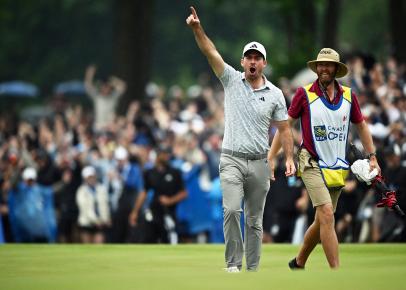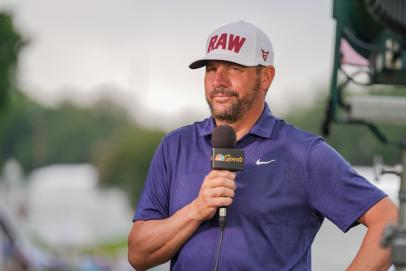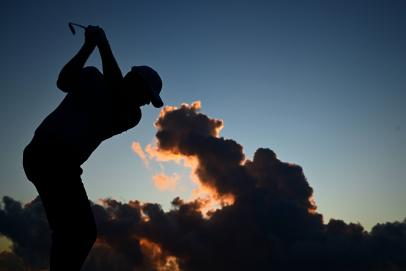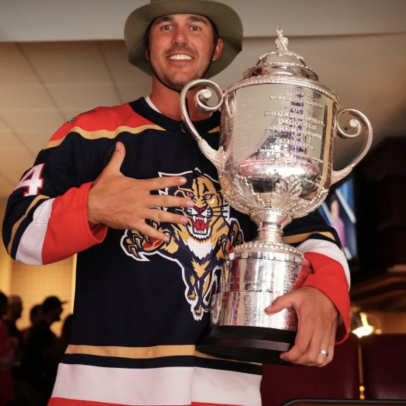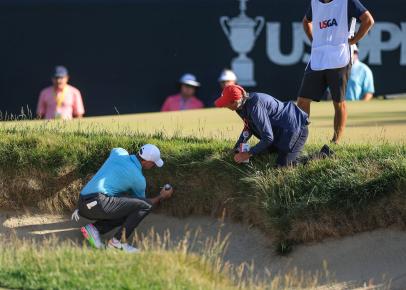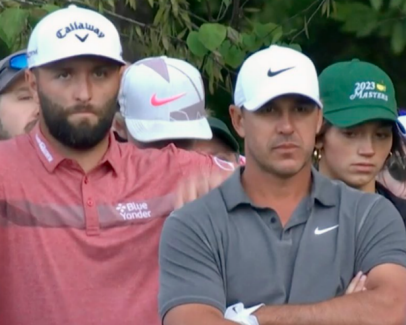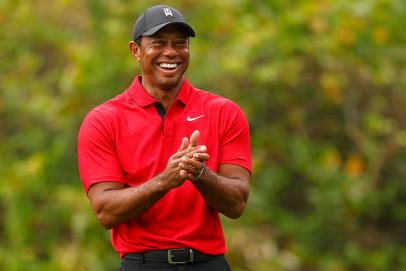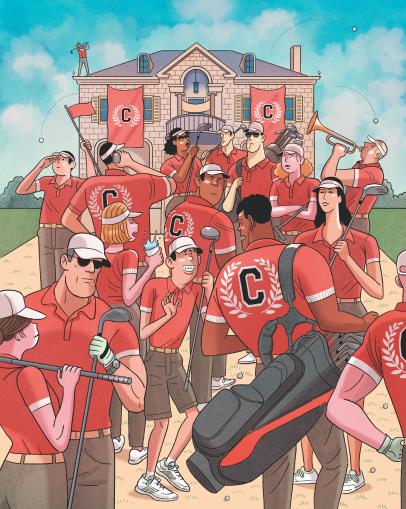Year in Review
Our favorite golf memories from 2023
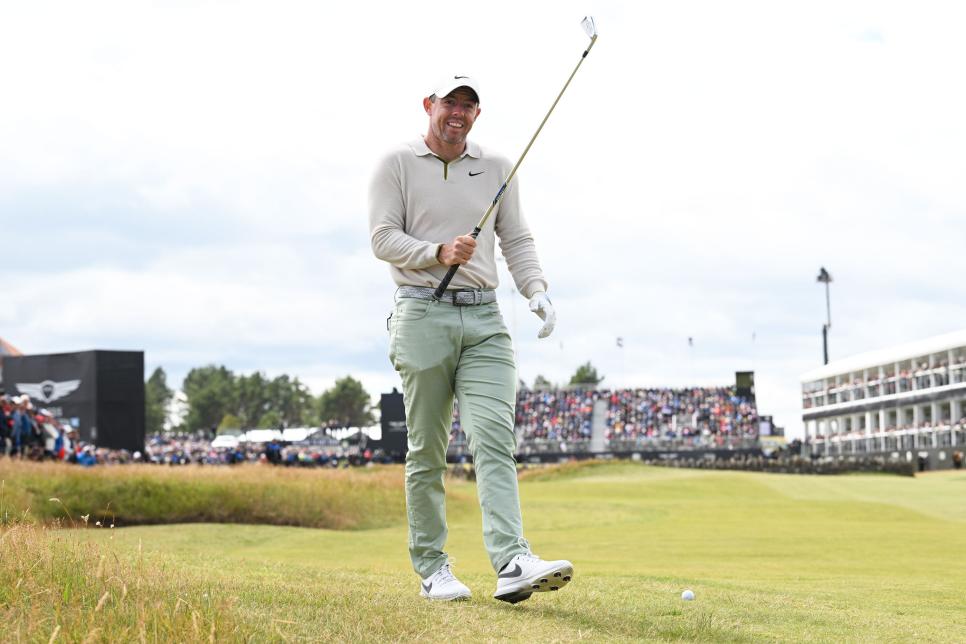
The PGA Tour vs. LIV/PIF vs. fans vs. pro golf’s future took up much of the oxygen in our sport in 2023, with a resolution to the mess still to come. Thankfully, there were plenty of more pleasant memories to sustain members of our Golf Digest staff this past year. Once more, we asked our writers and editors to supply us with what they’ll recall from the last 12 months. Their stories are personal and poignant, some for events they covered, some for events they competed in. Each tells its own unique story about what makes golf such a fantastic pursuit for anyone willing to tee up a ball, pick up a club and get lost in what comes next. Indulge us again as we share our favorite memories of 2023. —Ryan Herrington
My favorite golfer I met this year is one that few have heard of, and basically, that’s been the case throughout my golf writing career. Honestly, I’d rather talk to good-natured up-and-comers whose dreams have not been realized rather than eight-figure millionaires flying to tournaments on private jets every week.
Chase Johnson is a 27-year-old from Akron, Ohio, who had a breakout season on the Advocates Professional Golf Association Tour, which exists almost exclusively to give minorities true opportunities to advance in the game. It is an impressive organization overseen by an impressive man, Ken Bentley, who is stepping down at the end of this year.

Buda Mendes
Johnson, a Kent State alum, won three times on the APGA over a short, late-season stretch, captured the prestigious John Shippen Invitational, and he earned exemptions into two PGA Tour events, making the cut in Detroit and Cabo San Lucas, Mexico. He’s got game, and it would not be a surprise to see him reach at least the Korn Ferry Tour over the next few years.
But it’s not how Chase plays the game that makes him so admirable. It’s how the game has molded him. In short, he’s everything you would want your own child to be. He’s polite, caring and personable beyond words. He volunteers whenever had can at First Tee chapters. He really is a big kid himself, one who made friends with anybody in school. To this day he loves Harry Potter and Tiger Woods equally. That says it all!
Which brings me to my favorite story of the year. As a kid, Chase tried for years to get Tiger’s autograph when the Big Cat was competing at Firestone Country Club. The near-misses were excruciating—the worst one being Tiger reaching out for Chase’s cap, only to have people knock down the barrier and send Woods scampering.
Fast forward to this year’s World Wide Technology Championship in Cabo. As the course designer where the event was being played, Woods was on-site early in the week and happened to cruise up in a cart when Chase was on the first tee of his practice round. Tiger walked up, started talking to Chase, and the latter basically had an out-of-body experience. “I managed to remember my name,” Chase later texted me. They took a photo together, and on my end, I felt that giddiness that comes with getting to share, even slightly, in someone achieving a lifelong dream. Few things in this business are better.
There was an obvious follow-up question: Did Chase finally get Tiger’s autograph? Nope. “I’ll get the autograph when I get my first win,” he said. Anybody else, and I might have rolled my eyes. Coming from Chase, it just made me smile. —Tod Leonard
It still doesn’t feel real. Playing Augusta National on Monday morning after the Masters, in the same group as one of my good buddies, isn’t something this hack golf editor could’ve ever imagined. My podcast co-host Chris Powers and I felt privileged just to be having lunch on the veranda at ANGC’s clubhouse earlier in the week. It was surreal to be driving our rental car blasting a Jim Nantz Masters compilation on YouTube down Magnolia Lane that Monday, knowing we had a tee time lined up in an hour.
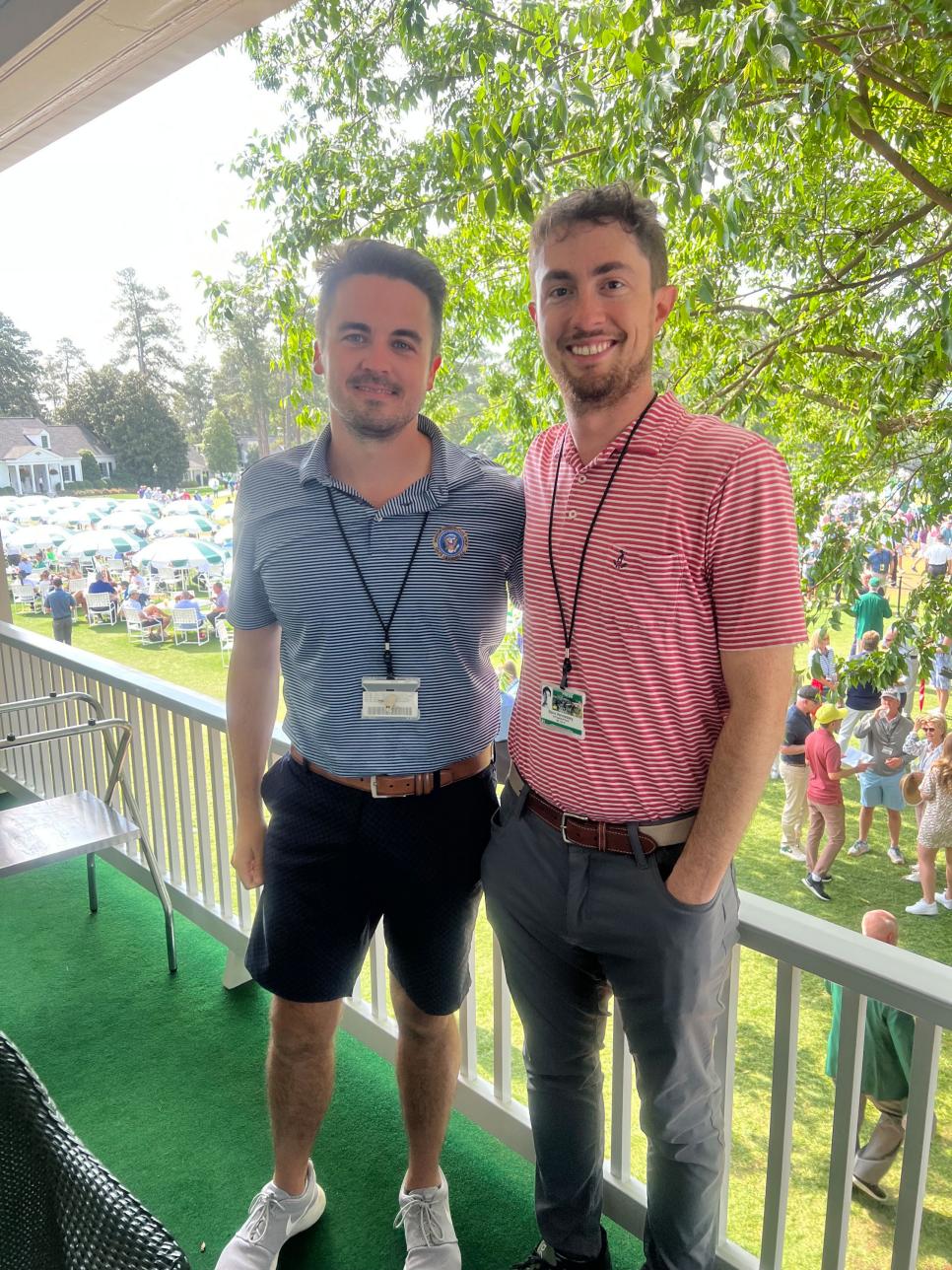
Christopher Powers and Stephen Hennessey on the Augusta National Golf Club veranda during Masters Week.
The whole experience was unreal. As I walked onto the first green, I half expected to be tackled by a Pinkerton security guard. Surprisingly, I got to study all 18 greens, usually for quite a while with my ball in hand after making a mess around the incredibly undulated greens. There were highlights: a birdie at No. 2 after a newspaper 7 on the first. Three pars in a row to start the inward nine, including a par at the 12th after chunking my tee shot into Spieth range. Then another three straight pars on 15, 16 and 17.
I’ll save you the shot by shot—we recorded a podcast about it if you care. (I’ve found it’s the only round where people actually care to hear about each hole, so you might find it worth listening to.)
The biggest takeaways: It’s tough to appreciate how tiny some of the greens are. The third and seventh in particular ... the precision needed to land and stop an approach gives you such an appreciation for Masters competitors. Of course, the fifth green is the opposite. It was so dang cool to study the internal contours ... again with my ball in hand.
From the members tees, it’s not that hard off the tee without any rough. The genius of the design is all in the putting complexes. I feel incredibly fortunate to have been able to experience something any golf fan could only dream about. To this son of a union electrician and a school secretary, it still feels like a figment of my imagination. —Stephen Hennessey
In case you hadn’t heard, my colleague/good friend Stephen Hennessey and I played Augusta National on the Monday after this year’s Masters. Until I have a child, it will remain one of the two greatest days of my life. And to be honest, it’s probably No. 1. I can say that because there is a 0 percent chance my wife reads this and curses me out for not saying our wedding day, which was also an all-timer, in fairness. A true 1A/1B situation.
As good as that day was, the lead-up was nearly just as good. There is simply nothing like going back to the rental house each night, ordering trash delivery food and throwing on “Live From” with co-workers past and present and breaking down everything that happened that day, and everything that could happen the following day. Or, just laughing our asses off at Brandel Chamblee driving the phrase “sensory blitzkrieg” into the ground (love you, Brandel). I’ll cherish those nights in Augusta just as much as I’ll cherish that Monday at Augusta, truly. Hopefully there’s many more nights like that to come, and maybe even another trip down Magnolia Lane as a player in my future, though apparently Steve and I have to wait seven years to enter the media lottery again. Already counting the minutes to 2030. —Christopher Powers
More from Golf Digest
Everybody lies.
One of my favorite characters in modern television, the irascible diagnostician Dr. Gregory House, suggested this idea in the pilot episode of the show that bore his name. His point was that the value of honesty was not fixed, not an undeniable truth, not even a standard operating procedure in human interaction, even at the very precipice of their own deaths. For most of us, I suppose this isn’t a surprise, especially one might say for a quasi-journalist like me. Sure, I still almost religiously adhere to the guidance of Ham Smith, my old J-School professor at Washington and Lee, who once attacked one of my seemingly innocent assumptions by pulselessly intoning, “If your mother says she loves you, check it out.” But covering golf for more than 30 years, I’ve operated in an ever-growing circle of universal trust. The game’s cornerstone is honesty, its inherent challenge an undeniable mirror to not only our physical abilities but more importantly our character. Here, in golf, lies ultimately only truth.
And then 2023 happened. The game of truth became in so many precincts and corners and domiciles a game of lies. Everywhere I looked I found only liars, half-truth tellers and, well, mendacity. Everything seemed made up or falsified or overstated beyond any semblance of actual reality. Where was there truth in so much of the proclamations coming from Greg Norman or Jay Monahan or Phil Mickelson or Jimmy Dunne? The inscrutability of the so-called “framework agreement” itself suggests at the very least a heavy dose of deception and borderline malfeasance. Could we trust Martin Slumbers or Mike Whan to deal only in facts?
Whether distance should be rolled back may be debatable (it probably should), but not because of any theories espoused by the ruling bodies. And what about the stories of Zach Johnson or Patrick Cantlay, or worse yet, the incendiary half-truths disguised as “reporting” over the U.S.’s splintered team room at Marco Simone? And for as forthright as Rory McIlroy has been in this anus horribilis, even he found the truth malleable about who should and should not be considered for the European Ryder Cup team between the start of the year and its end.
Speaking of which, when 2023 finally concluded with Jon Rahm dashing off to the LIV golf league by echoing one of the rival golf entity’s most patent absurdities (“grow the game”), the end of honesty seemed complete. Indeed, Rahm’s self-imposed (cough, cough) silent period is the grandest example of living a lie that we’ve seen in golf since, well, the year started with the whopper of an untruth told by Aaron Rodgers and his 10-handicap to win the AT&T Pebble Beach Pro-Am.
I came away from all the to-ing and fro-ing as much exhausted as disgusted, lost at sea in what I thought big G Golf was and what it really is. And a bit hopeless. But before I closed the book, I remembered reading about a simple but incredible instance of honesty, the kind that rests at the game’s core. Tommy Kuhl (below) shot a course-record 62 at Illini Country Club to win the U.S. Open qualifier in May, or at least he thought he had until he realized on his own that he had violated the rule on fixing aeration holes on the greens. Only he knew he had; only he knew that if he hadn’t said anything he’d be one step toward playing the U.S. Open for the first time; only he could tell the truth and disqualify himself. Which is what he did. "I felt sick to my stomach," Kuhl told MondayQ.com. "I knew I wouldn't be able to sleep if I didn't tell the rules official. ... I should know better."
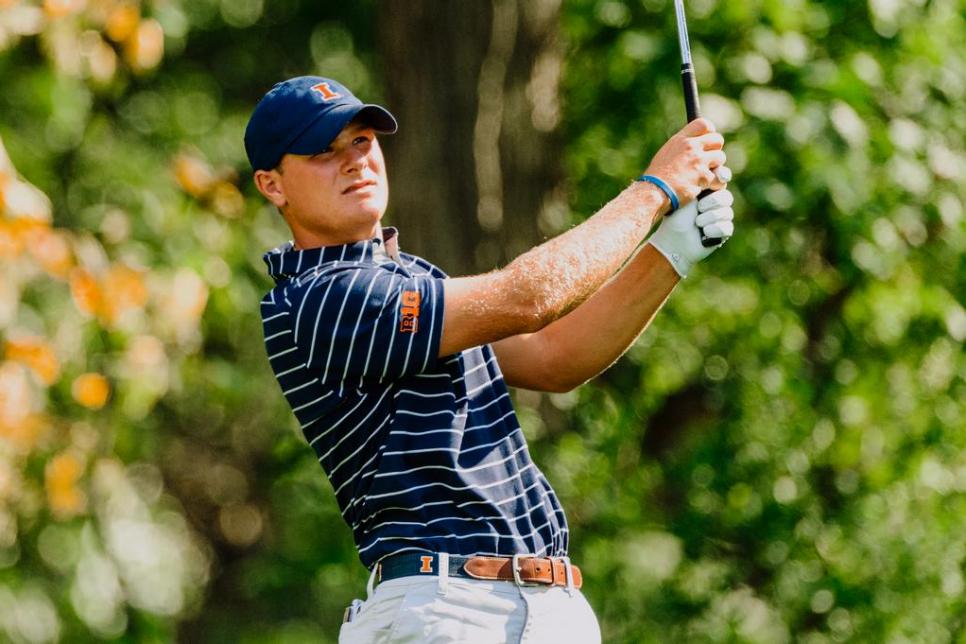
Craig Pessman/Illinois Athletics
A moment of truth in a year of lies. There’s honor in that. And a kind of hope for 2024. —Mike Stachura
Our love for golf has been put to the test this year, but I'm lucky to have an annual reminder of how the game, stripped to its essentials, can transcend all the unpleasantness. It's called The Channels Cup and is probably just like thousands of other Ryder Cup-style events organized by hackers around the globe, but this one is mine, and this year I needed it more than ever. It was a spiritual palate cleanser, and not because of the competition; my team, Carolinas & Canada, won so convincingly that it left the bad guys, Team World, in a state of utter humiliation from which I'm not sure they'll recover. (They've had their moments in the past, but none of their players write for Golf Digest, so that information is currently unavailable.) I'm not even sure it's about "friendship," although it is definitely a little bit about friendship.
Instead, I'd like to use the word "community." This year, my friend Lawton hosted us in Spartanburg, S.C., and went all out with insane catered dinners, various gifts including personalized stickers full of inside jokes made by his genius wife Rachael, and a Saturday night hangout at a bar, where an inside joke that would take too long to explain was featured on the marquee. I took care of the courses—thank you. Village Greens and Links O’Tryon. Zac booked a house. Chris gave a speech. He and Ivan made hype videos. Colin designed the live updating spreadsheet. Joanna ran the media ops (yes, really). Jake is writing the oral history (yes, really). People who weren't even there made videos, and others brought beer and liquor and [redacted]. It was a giant community event that became huge, to us, by virtue of total participation between people who love each other. But golf was the conduit—golf was the excuse, because in various ways we all love golf, too.
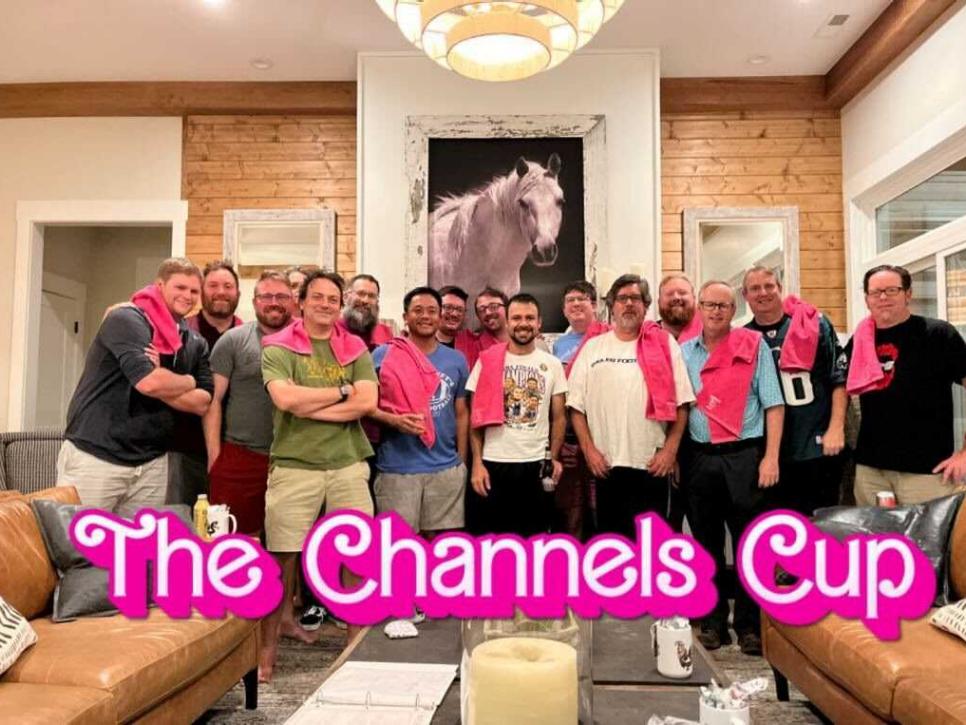
Don't underestimate the conduit; it's the thing that lets special bonds flourish, and I don't think any game has quite the same mix of drama and romance and spirit. If you feel down about the state of the sport at the highest levels, please, go back to the lowest levels and let golf remind you of what it is. —Shane Ryan
Like many journalists covering the 105th PGA Championship at Oak Hill Country Club in Rochester, N.Y., I was wholly impressed by the performance of California club pro Michael Block as he earned an exemption into the 2024 PGA via his top-15 finish. His astounding week on the East Course, highlighted by that final-round hole-in-one in the presence of Rory McIlroy, made for great copy. The guy became a celebrity—and rightly so. He seemed made the moment. Block might be one of the most inspiring stories of the year, but we'd remiss to not give the nod on the inspiration scale to another Californian, a young aspiring pro who competed a month later in the U.S. Open at Los Angeles C.C. Corey Pereira, 28, made his PGA Tour debut that week after advancing through both local and final qualifying. Several players successfully navigated the combined 54-hole process, but Pereira, who had lost his Korn Ferry Tour status the previous summer, had done so without playing any other competitive round on any tour anywhere.
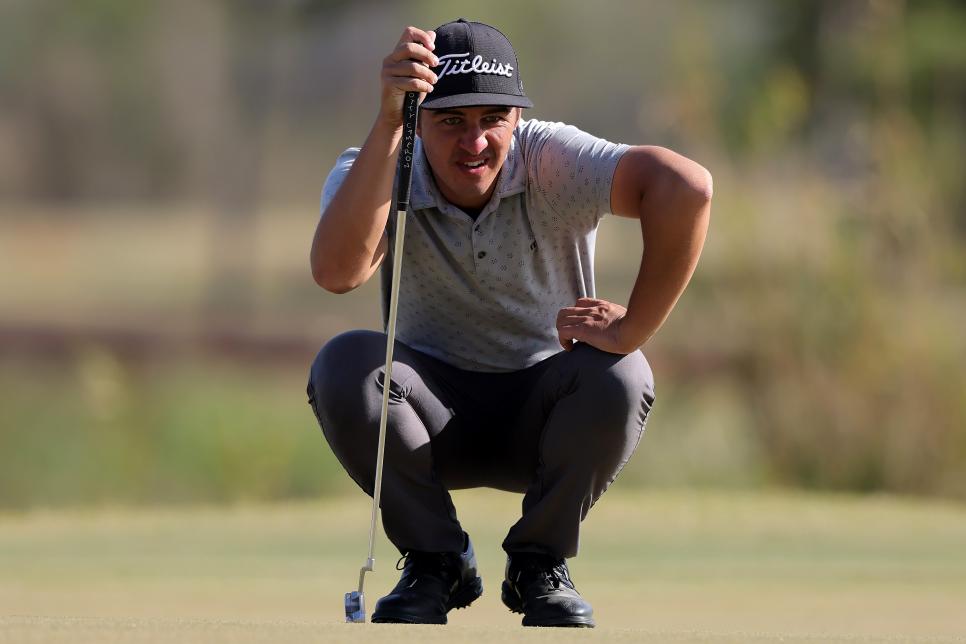
Jonathan Bachman
Pereira had all but shelved his career aspirations to care for his girlfriend, Leah Bertuccelli, 26, who was diagnosed with cancer a year ago September. After his coach, Phil Dawson, talked him into trying the qualifier, Pereira somehow got through the local and then finished T-3 in the final qualifier in Columbus, Ohio, where many tour players compete after the Memorial Tournament.
Pereira didn't make the cut at LACC, shooting 71-76, but the win was just getting there and having Leah attend when she was supposed to be undergoing her final radiation treatments at Stanford. He referred to the week as "a blessing." How could you not be touched by his story. —Dave Shedloski
It took nearly a quarter century, but my high school friends finally had enough interest to put together a buddies golf trip—a weekend getaway to Turning Stone Resort & Casino, a place I’m all too familiar with from my annual buddies golf trip with a different group. And while it certainly had a different feel than that yearly sojourn of more serious golfers, it turned out to be worth the wait.
Was there a little more on-course (and off-course) drinking? Yes. Was there a steakhouse dinner that cost about as much as all the meals on my usual trip combined? Yes. But was there fun competition and bonding through the greatest sport in the world? Also, yes.
Unfortunately, the weather didn’t cooperate, and 72 holes turned into 54—or even less for some who couldn’t quite finish in a chilly downpour that left everyone soaked—but the overall vibes couldn’t be dampened. Whether on the course or inside a clubhouse enjoying beers, there’s never a bad location to catch up with longtime pals.

A short-time golfer, Stephen McDermott, a 25-handicapper who didn’t start playing until he turned 40 last year—I call him the 40-year-old (golf) virgin—wound up winning our inaugural competition among this group of Pelham H.S. Class of 2000 grads. For his effort, Steve took home a kid’s-sized title belt that was hastily ordered days before the trip. But we could have handed him an empty soda can as a prize and it wouldn’t have wiped the smile off his face.
It’s about time this group took a golf trip, and I can only hope this special getaway becomes another yearly tradition (Pending permission on the home front, of course). Because, apparently, the only thing better than going on one annual golf trip, is going on two. And in addition to the coveted green jacket I play for on my other one, I want to bring that silly, small belt home next summer. —Alex Myers
Needing a closing par to force a playoff with Robert MacIntyre in the Genesis Scottish Open at the Renaissance Club in East Lothian, Rory McIlroy was just off the fairway to the left on a 483-yard par 4 that had yielded only two birdies that day. Into a stiff breeze, securing par—or better—required a shot of some imagination.
“It was a perfect 3-iron, but I didn’t have a 3-iron in the bag,” said McIlroy after making the birdie that bequeathed his maiden professional victory in Scotland. "So it was case of either turning a 4-iron into a 3-iron, or a 2-iron into a 3-iron. I was over a 4-iron first, but couldn’t see how it was going to get over the false front of the green. So I went from hitting a big draw with the 4-iron to hitting a little cut with the 2-iron.”
It came out “perfect,” just as the Northern Irishman had imagined, never climbed more than 30 feet above the rumpled fairway and finished 10 feet, 8 inches from the flag. Fittingly, he made the subsequent putt. “I’ve probably hit shots that have been more consequential in bigger events, but in terms of just the pure quality of the shot I’m not sure if I’ve ever hit one as good as that,” claimed McIlroy.
Indeed, especially for those of a certain age, this thing of beauty was a creative throwback, a delicious reminder of the shot-shaping elite golf has largely lost in these ever-more scientific and decreasingly artistic times. —John Huggan
Six days remain in the year and my favorite golf moment has not yet happened. You see, Bandon Dunes awaits.
My 17-year-old son, two buddies and I are jumping on a 6 a.m. flight on Tuesday—the day after Christmas—to head to Oregon for four days. I’ve been lucky enough to visit the resort four times, but my three companions this time are all Bandon rookies. They have no idea what they’re about to experience.
Few things in the game are guaranteed to exceed expectations like Bandon. It may be chilly, it may be windy, it may be rainy ... or it may not. But it doesn’t matter. Spending time with my son and two friends there over the final few days of the year will over-deliver and be my favorite golf moment of the year. —Jay Coffin
There is no shortage of theories to explain why the Americans continue to lose and lose big on the road at the Ryder Cup. Among that conjecture is the belief the U.S. team does not care, or care to the same degree of their European counterparts, and given reports of possible protest or banishment over payment concerns, maybe there’s some truth to it. Which is why one of the most indelible moments from Rome, and from the year, was the sight of Scottie Scheffler in tears on Saturday afternoon.
The World No. 1 was coming off the business end of a historic loss—he and Brooks Koepka getting bounced 9 and 7 by Viktor Hovland and Ludvig Aberg in the morning session. Not long after, Scheffler was folded over in a cart, his hands over his head and his wife’s arms around his shoulders. Those big hands could not conceal the drops pouring from Scheffler’s eyes. It was jarring, partly because the 27-year-old Texan is not one prone to emote, and when he does it’s usually in celebration. But it was also jolting because of where the breakdown happened, which was in front of everyone to see.
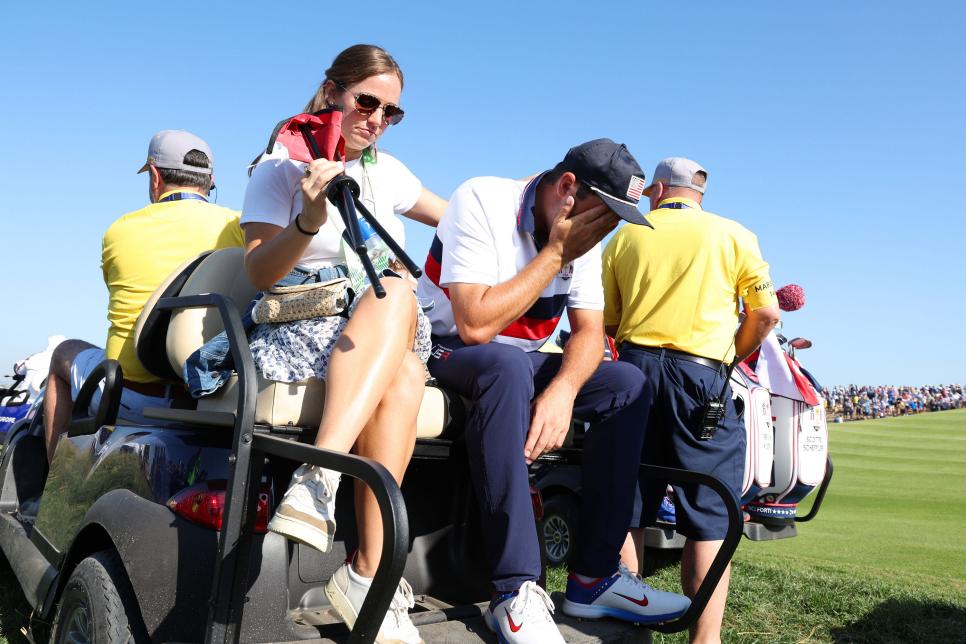
Jamie Squire
Scheffler is not the only star to find himself in such a situation at the Ryder Cup, and it should be noted that many in that position are nowhere to be found after falling short (including at Marco Simone). But instead of leaving the property, Scheffler stayed on the course, cheering his team on that afternoon through the hurt. Because the very thing that reduced him to sobbing is the same emotion that kept him there, which is being a part of something bigger than yourself.
Scheffler was embarrassed by his play, sure, but the true cause of those tears was the belief that he had let his team down. And if you judge golfers by score alone, we suppose that’s the case. Yet, against the backdrop of U.S. team whispers, against the greed and money that have dominated the professional game the past two years, Scheffler and his tears were a good reminder why we as fans are drawn to sports in the first place. —Joel Beall
Birthdays are often a tumultuous time for me. I appreciate the attention and despise the fact that I’m one year closer to an AARP membership. This year, because of some fortuitous scheduling, my birthday coincided with Golf Digest’s Seitz Cup, our annual company Ryder Cup-style event between the oldest among us at the company and the youngest. Thankfully, for my mental health, I’m still on the latter team. I’m not going to say that I was playing great, but I was playing great for me. There’s a big difference there.
Youth ultimately prevailed, as did my playing partner Patrick Andrews and I. We joined our team in the celebation at the course, feeling very good about our accomplishments. The merriment continued on the car ride home consisted of Taylor Swift (because of course, it did) and a very mature game in which we attempted to get passengers of nearby cars to wave back to us. If this is what the rest of 28 is like—beautiful days on the course, blasting Red and a bunch of idiots acting like fools—it’s going to be a pretty good year. —Greg Gottfried
The past year was one of the most frustrating golf years of my life. Now a full three years removed from working at a golf course and playing several times a week and consistently posting impressive scores, my Handicap Index had been steadily and rapidly increasing for longer than I’d care to admit. Among other things, surely, my game had two major flaws: my short game and my setup.
The former had gotten so bad it was becoming embarrassing. Any shot inside 100 yards was terrifying. I’ll put it this way: I putted from 67 yards to a front pin with water behind the green in our company outing this year (and got up and down for birdie, not to brag).
Second, my feet were too close together, causing a wicked over-the-top swing path resulting in some disturbing misses. It threw off my tempo and just about everything else.
That brings me to this year’s Hot List Summit—stay with me, this is all connected. Part of our process at the Hot List involves teaching pros and master club fitters. In a matter of minutes, with two small changes apiece, one teaching pro fixed my short game—on Bermuda grass, no less—and a master fitter adjusted my setup to allow for a more athletic move at the ball. The next three rounds were the best of my year.
I marveled at how simple some of these changes were. It felt like I was going to have to accept that I was going to continue getting worse at golf forever. Instead, after just 15 minutes or so of instruction, I feel as confident as I have in years. So, for anybody coming off a tough year, or years, or simply lacking some confidence, don’t be afraid to take some lessons. You could be 15 minutes from enjoying the game again. —Jared Goldstein
Was it worth it?
The question ran through my head at the Chevron Championship in April, where, for the first time in 51 years, the LPGA Tour's opening major was hosted not in Palm Springs, Calif., but The Woodlands, Texas, a move to get the major closer to Chevron's corporate headquarters in another chapter of golf's cash-conscious era. Gone was the storied history of the Dinah Shore course in exchange for a $2.1 million purse increase to $5.2 million.
Yes, money talks, but it feels like the LPGA sold low. Despite the purse expansion, the Chevron remains the smallest purse of the tour's five majors, as its 2023 purse was less than half of the U.S. Women's Open's $11 million. Early indications appear that Chevron will raise the purse closer to a rate more in line with its corporate dividend than its major peers, as the purse only went up $200,000 to $5.2 million from Chevron's 2022 takeover of the major to this year.

Carmen Mandato
The LPGA did try to pay homage to the event's roots, from naming the area around the 18th green the Dinah Shore pavilion and providing another white bathrobe for the winner. But as I watched Lilia Vu prepare to jump into the murky waters, fresh off the first of what would be two major championship wins in 2023 during an ultimate year to remember, it all felt like an awkward effort to tap into a past no longer associated with this event. Amy Alcott leaping into the water next to the 18th in Rancho Mirage, Calif., as a fitting celebration to take off the Palm Springs heat was natural. This leap? In the cold, while it's drizzling and I'm holding multiple hand warmers? I could never.
Instead, The Country Club at Carlton Woods has already introduced its water-related traditions. The finish of the second round got delayed until Saturday morning due to rain delays, which will end up more of a feature than a bug of the major. The Woodlands averages 50 inches of rain annually compared to Palm Springs's five.
The move marks another lost tie to the LPGA's 74-year history, arguably one of the tour's greatest strengths as the longest-running professional women's sports organization in the United States. It felt even more painful as the tour lost the final of its original 13 founders, Marlene Hagge-Vossler, in May.
As the LPGA focuses more and more on purse growth, was a relatively small major purse increase worth the tradeoff of leaving the tour's most iconic venue behind? For this writer, it certainly was not. —Kent Paisley
To my knowledge, I don’t have attention-deficit disorder, but perhaps I have a golfer’s version. I’m not quite sure what else to call my incessant need to try every tidbit of golf instruction on Instagram, YouTube or colleague Luke Kerr-Dineen’s Twitter page. Oh, maybe that’s my problem; I’ll turn my body more; I’ll stop turning my body so hard; I’m too steep; I’m too shallow.
But what else am I supposed to do when Tiger Woods is lecturing Scottie Scheffler on why he doesn’t take divots when he’s hitting it well? If you missed it, the video from a TaylorMade shoot when viral earlier this year, followed by a more recent explanation from Woods on how, when he was in his prime, he was “wide and wide” and “zeroed,” resulting in very few divots.
Maybe that’s my problem. Currently, I’m convinced it is, but then again, I’ve been here before. Fix, unfix. New fix, unfix. Tiger won with four different swings? I’ve lost with 12.
Which leads me to the golf memory I’ll take from 2023. I was at a media preview event at Streamsong Resort for the opening of The Chain, golf’s latest no-rules short course, and I was fortunate enough to be in the first group to ever play the Bill Coore and Ben Crenshaw design. Both men joined us for the event and were on the first tee.
Why do I need to stop taking divots? Well, I’m more comfortable hitting a 4-iron from thick rough than a sand wedge off soft turf. Chunk. So, yes, I was quite nervous when I was faced with a 95-yarder off dewy, sandy Bermuda at 7:30 a.m. in front of a Masters champion and two of the game’s most celebrated architects.
I didn’t take a divot. Nope, I hit that low, spinning wedge shot that somehow rewards you for hitting it two or three grooves low. One hop and stop to three feet. I’ll spare you the cliché.
Like Tiger, when I’m flushing it, I don’t take divots. —Drew Powell
They say golf is a game of redemption and my favorite memory of the year falls squarely in that category.
One of the great things about playing at a private club is you truly get to know folks and one of the more popular guys (among a number of popular guys) is Jim Celentano, a fast-swinging lefty whose handicap typically stays in the 11 to 14 range.
Unfortunately for Jimmy C, as everyone calls him, he had the misfortune of botching an 18-inch bunny to lose the annual member-member event at our place in Connecticut. As tight-knit as our club is, we felt for the guy but, of course, used it as ribbing ammo. At the dinner before our biggest event of the year, the Nassau, club president Eugene Singer started his remarks by saying, “I’ll keep it short. Not as short as the putt Jimmy C missed in the member-member, though.” Ouch.
Jimmy C had the good fortune to draw a good team for the Nassau and they were in the thick of it for the title. A two-round ABCD format with the best two of four, net, counting, there is, shall we say, a fair amount on the line. Come the final nine on Day 2, with golf carts filled with spectators starting to gather, Jim staked a shot to three feet on No. 11 for a natural birdie and contributed several other times. None more important than at the last, a par 3. With two players likely not making par, Jimmy C hit a greenside bunker shot to eight feet and made the downhill right-to-left putt, letting go with his signature “Come on!!!!!” roar that was only drowned out by the applause and cheers of those watching as his team sewed up the title.
I waited for most of the well-wishers to offer their congratulations. When things quieted down a little, I walked up to Jimmy C, sitting in a cart and clearly overcome with emotion. “MJ, I need a moment,” he said.
Take all the time you need, pal. Because you had quite the moment. —E. Michael Johnson



